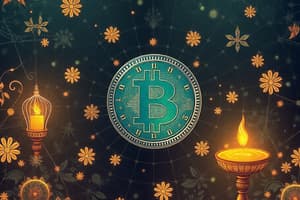Podcast
Questions and Answers
What is the main characteristic of commodity money?
What is the main characteristic of commodity money?
- Difficult to exchange for goods
- Heavy and hard to transport (correct)
- Backed by a government
- Easily transportable
Why might an individual be willing to save their cigarettes in the context provided?
Why might an individual be willing to save their cigarettes in the context provided?
- Because they believe in smoking cessation
- Due to the belief that cigarettes can be exchanged for other goods in the future (correct)
- Because they enjoy collecting cigarettes
- As a way to increase their smoking habits
What is a disadvantage of electronic money as mentioned in the text?
What is a disadvantage of electronic money as mentioned in the text?
- Heavy and hard to transport (correct)
- Difficult to use for online transactions
- Can lead to privacy concerns
- It is subject to counterfeiting
In the evolution of the payments system, what is likely to precede the use of paper currency?
In the evolution of the payments system, what is likely to precede the use of paper currency?
What is declared legal tender by governments but is not convertible into coins or precious metals?
What is declared legal tender by governments but is not convertible into coins or precious metals?
Legally, what must governments do when paper currency is decreed as legal tender?
Legally, what must governments do when paper currency is decreed as legal tender?
Which of the following best describes how recent financial innovation has impacted the Federal Reserve's job of conducting monetary policy?
Which of the following best describes how recent financial innovation has impacted the Federal Reserve's job of conducting monetary policy?
As the pace of financial innovation quickens, how does defining money become?
As the pace of financial innovation quickens, how does defining money become?
What are monetary aggregates?
What are monetary aggregates?
Which is the narrowest monetary aggregate reported by the Fed?
Which is the narrowest monetary aggregate reported by the Fed?
What does the currency component of the U.S. M1 money supply include?
What does the currency component of the U.S. M1 money supply include?
What are the components of the U.S. M1 money supply?
What are the components of the U.S. M1 money supply?
Which of the following is considered a form of e-money?
Which of the following is considered a form of e-money?
What is a smart card equivalent to in terms of traditional currency?
What is a smart card equivalent to in terms of traditional currency?
Why has the paper payments system not been completely replaced by electronic payments systems?
Why has the paper payments system not been completely replaced by electronic payments systems?
What slows down the transition to a system where all payments are made electronically?
What slows down the transition to a system where all payments are made electronically?
Which payment method is NOT classified as e-money?
Which payment method is NOT classified as e-money?
What differentiates e-money from traditional physical currency?
What differentiates e-money from traditional physical currency?
Flashcards are hidden until you start studying
Study Notes
Commodity Money
- Commodity money has intrinsic value, meaning it has value even outside of its use as money.
Saving Cigarettes
- Individuals may be willing to save cigarettes in a context where cigarettes are used as a form of money because they represent a store of value that can be used for future transactions.
Disadvantage of Electronic Money
- A disadvantage of electronic money is the risk of system failure or hacking, which could lead to the loss of funds.
Preceding Paper Currency
- The use of paper currency is likely to be preceded by the use of precious metals as a form of money.
Legal Tender
- Fiat money is declared legal tender by governments, which means it is accepted as a valid form of payment for debts and taxes. However, it's not convertible into coins or precious metals.
Government Obligations
- When paper currency is decreed as legal tender, governments must legally accept it as payment for taxes and other public dues.
Financial Innovation's Impact on Monetary Policy
- Recent financial innovation has made it more difficult for the Federal Reserve to conduct monetary policy, as it becomes harder to measure the money supply and predict the impact of policy changes.
Defining Money
- Defining money becomes increasingly challenging as the pace of financial innovation quickens, due to the emergence of new forms of payment and financial instruments.
Monetary Aggregates
- Monetary aggregates are measures of the money supply that represent a particular definition of money.
Narrowest Monetary Aggregate
- The narrowest monetary aggregate reported by the Fed is M1.
Currency Component of U.S.M1 Money Supply
- The currency component of the U.S.M1 money supply includes physical currency like paper bills and coins.
Components of U.S.M1 Money Supply
- The components of the U.S.M1 money supply include:
- Currency
- Traveler's checks
- Demand deposits
- Other checkable deposits
Form of E-Money
- Stored-value cards are considered a form of e-money.
Smart Card and Traditional Currency
- A smart card is equivalent to a prepaid debit card in terms of traditional currency.
Persistence Of Paper Payments
- The paper payments system has not been completely replaced by electronic payments systems due to factors like:
- Lack of access to technology in some areas
- Security concerns
- Resistance to change
Transition to Electronic Payments
- The transition to a system where all payments are made electronically is slowed down by factors like:
- Infrastructure development
- Consumer adoption
- Security concerns
Non-E-Money Payment Method
- Credit cards are classified as non-e-money payment methods.
Differentiating E-Money
- E-money is differentiated from traditional physical currency because it exists solely in electronic form and does not have intrinsic value.
Studying That Suits You
Use AI to generate personalized quizzes and flashcards to suit your learning preferences.



